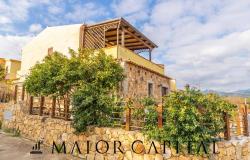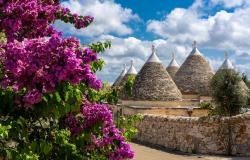Olives and prosciutto tickled your palate, lasagne oozed meaty creaminess, brasato released its boozy flavours and you lost yourself in a tiramisu. But if you are having a proper Italian meal, the best is yet to come—a small glass of amaro.
Amaro is the quintessential Italian liqueur and the perfect end to any self-respecting meal.
Dating back from Greek and Roman times, the amaro tradition has remained blissfully alive in Italy, even though it vanished from other countries.
The practice of preparing elixirs, as amari were called in ancient times, was especially common in medieval Europe thanks to the Arabs, who introduced distillation and perfected infusion techniques.
Bizarrely, medieval elixirs started life as alchemic catalysts to be used in gold making—one of the greatest preoccupations of the time—but they later acquired a reputation as formidable remedies (as they had in Roman times). While it soon became clear that no amount of alcohol-soaked plants would produce gold, European alchemists remain persuaded that elixirs had beneficial qualities and, in particular, could prolong life—a belief they shared, or perhaps imported from Chinese culture.
They were not entirely wrong. Although elixirs didn’t quite manage to make people immortal, they certainly aided digestion and, in some cases, invigorated the body, exploiting the tonic properties of herbs and spices—with the added advantage that, since the tinctures were diluted with sugared water, they also tasted pleasantly bittersweet, unlike many of today’s medicines.
Elixir-making often took place in monasteries, which had long been the repositories of herb lore. In much of central and northern Europe, monks made their liqueurs out of plants, roots and fruit. But in medieval Italy, where Arab influence was strong, elixirs were also prepared with spices, which are typical of the Middle-Eastern tradition. This combination is still present in many Italian amari. Throughout the centuries, amaro-making remained the preserve of monasteries and private homes. In the mid-1800s, however, the first commercial amari reached the market. Many of today’s best known brands, including Fernet Branca, Averna, Montenegro and Braulio, made their appearance at the time. Some of the manufacturers developed secret recipes, such as Fernet, whose exact formula is still jealously guarded more than a hundred yers on. Others, such as Averna, popularised regional products—like every other culinary expression, Italian amari are closely linked to their terroir, employing local plants and ingredients in their blends.
Throughout the centuries, amaro-making remained the preserve of monasteries and private homes. In the mid-1800s, however, the first commercial amari reached the market. Many of today’s best known brands, including Fernet Branca, Averna, Montenegro and Braulio, made their appearance at the time. Some of the manufacturers developed secret recipes, such as Fernet, whose exact formula is still jealously guarded more than a hundred yers on. Others, such as Averna, popularised regional products—like every other culinary expression, Italian amari are closely linked to their terroir, employing local plants and ingredients in their blends.
In the early twentieth century, poet and bon vivant Gabriele d’Annunzio, who had a penchant for all things alcoholic, was instrumental in bringing amari to national attention—especially Montenegro, which he named ‘the virtuous liqueur.’
Since those days of free publicity, amari have also been one of the earliest examples of successful marketing. Their advertisements, from Averna’s celebrated line—“the full taste of life”—to the heartwarming scene where a group of Amaro Montenegro-guzzling friends saves a herd of horses to the rhythm of Morricone’s Once Upon a Time in America, are the most iconic in Italy.
Whether you like it nostalgic, romantic, historic, very bitter or very sweet, Italy has an amaro for you. Even better, if you are not Italy bound for a while, the amaro is a small taste of Bel Paese in a glass that you can savour at home. We have selected three of the very best, and suggested three more for you to try. Just one word of warning: amari are potent and rich in alcohol, so drink sparingly.
Fernet Branca
 Noticeably bitter and intensely aromatic, Fernet Branca is the most mysterious of all Italian amari. Its recipe has been a secret since the mid 19th century, when it was first produced by Milanese distillery Fratelli Branca. It is not even clear who developed it—maybe a Milan-based Swedish doctor, maybe a crafty housewife who married into the Branca family—or why it was named Fernet. Some stories have it that the Swedish doctor who came up with the recipe was a Dr Fernet; others say that the name comes from the Milanese words fer net (clean iron) as an iron bar was immersed in the liquid to make it shinier.
Noticeably bitter and intensely aromatic, Fernet Branca is the most mysterious of all Italian amari. Its recipe has been a secret since the mid 19th century, when it was first produced by Milanese distillery Fratelli Branca. It is not even clear who developed it—maybe a Milan-based Swedish doctor, maybe a crafty housewife who married into the Branca family—or why it was named Fernet. Some stories have it that the Swedish doctor who came up with the recipe was a Dr Fernet; others say that the name comes from the Milanese words fer net (clean iron) as an iron bar was immersed in the liquid to make it shinier.
The one certain thing is that the amaro is a blend of 27 or so ingredients, among which are both herbs and spices from four different continents, including saffron, Chinese rhubarb, South African aloe and South American cinchona. They are soaked in alcohol and diluted with more alcohol and sugar, before the liqueur is aged in oak barrels.
Just as the ingredients come from virtually every continent, so is the finished product sold throughout the globe. Outside Italy, it is often drunk in cocktails or (gasp!) with Coke, but the most traditional way to serve it is straight or on ice (www.fernetbranca.com). For another amaro with a secret recipe, try: Amaro Montenegro, first made in 1885 by herbalist Stanislao Cobianchi. Cobianchi fled his native Bologna to avoid becoming a priest and, during his wanderings, tasted a divine liqueur in Montenegro. Back in Italy, he tried to recreate the flavour, and Amaro Montenegro was born. Or at least that’s one story—another has it that clever Cobianchi named the amaro after Princess Jelena of Montenegro, future Queen of Italy. Serve straight or on ice (www.montenegro.it).
For another amaro with a secret recipe, try: Amaro Montenegro, first made in 1885 by herbalist Stanislao Cobianchi. Cobianchi fled his native Bologna to avoid becoming a priest and, during his wanderings, tasted a divine liqueur in Montenegro. Back in Italy, he tried to recreate the flavour, and Amaro Montenegro was born. Or at least that’s one story—another has it that clever Cobianchi named the amaro after Princess Jelena of Montenegro, future Queen of Italy. Serve straight or on ice (www.montenegro.it).
Centerba or Centerbe
 Centerba is one of the oldest and most powerful Italian amari. Its tradition harks back to Roman times—legend has it that Pliny the Elder was one of Italy’s first centerba makers.
Centerba is one of the oldest and most powerful Italian amari. Its tradition harks back to Roman times—legend has it that Pliny the Elder was one of Italy’s first centerba makers.
Over the centuries, the amaro was prepared in monasteries and homes throughout Italy, and particularly in Abruzzo. Here, in 1817, a chemist from Canzano, Beniamino Toro, created a powerful variant with a whopping 70% alcohol content (amari usually range between 17% and 35%). He used it to cure just about anything, including the plague.
As the name implies, Centerba is made with many herbs, though perhaps not quite a hundred, which are soaked in alcohol for a few months and distilled. The recipe varies from monastery to monastery and from distillery to distillery, but it usually includes sage, rosemary, basil, parsley, mint, juniper berries, and cloves.
Fratelli Toro, the company run by the heirs of Beniamino Toro, make an Amaro alla Centerba with 30% alcohol content (as well as the 70% liqueur an a 45% one), all with wild herbs from the Majella mountains (www.centerbatoro.it).
For another herby amaro, try: Amaro Braulio, made with herbs, roots and berries from Valtellina and aged for two to five years in oak barrels (www.amarobraulio.com).
Averna
 The origins of this Sicilian amaro are wrapped in legend. Story has it that a Capuchin friar from Caltanisetta, in Sicily, called local notable Salvatore Averna to his deathbed. Averna was an upstanding citizen and church benefactor and the friar wanted to give him a present before passing away. He bequeathed the bemused man a minutely written scroll.
The origins of this Sicilian amaro are wrapped in legend. Story has it that a Capuchin friar from Caltanisetta, in Sicily, called local notable Salvatore Averna to his deathbed. Averna was an upstanding citizen and church benefactor and the friar wanted to give him a present before passing away. He bequeathed the bemused man a minutely written scroll.
When Averna got home, he was shocked to discover that the scroll contained the secret recipe for an amaro that the Capuchins had been making since time immemorial. Once the surprise wore off, though, Averna spotted the commercial opportunity—and here myth ceases and history begins.
The Averna family started selling the local amaro in 1868. It met with enormous success and, in 1895, the then king of Italy, Umberto I, liked it so much that he gave the Avernas a golden brooch bearing his family crest. The amaro then got a royal warrant in 1912 thanks to Umberto’s successor, Vittorio Emanuele III. Interestingly, Averna was also one of the first Italian companies to be managed by a woman entrepreneur—Anna Maria Averna took it in her hands after her husband died in the early 1900s. The group is still owned by her descendants.
Interestingly, Averna was also one of the first Italian companies to be managed by a woman entrepreneur—Anna Maria Averna took it in her hands after her husband died in the early 1900s. The group is still owned by her descendants.
Dark, soft and round, herby but not too bitter, Amaro Averna is one of Italy’s best sellers and has an increasingly international market. Serve straight or on ice (www.averna.it).
For another amaro with royal seal of approval try: Amaro Lucano, a sweet, spicy liqueur from Basilicata. The recipe, created in 1894 by Pasquale Vena, a bartender from Pisticci, is still a secret. Apparently, only the members of the family that owns Amaro Lucano are allowed to take part in the final production stages, ensuring that the technique remains strictly confidential. Serve straight or on ice (www.amarolucano.it).













